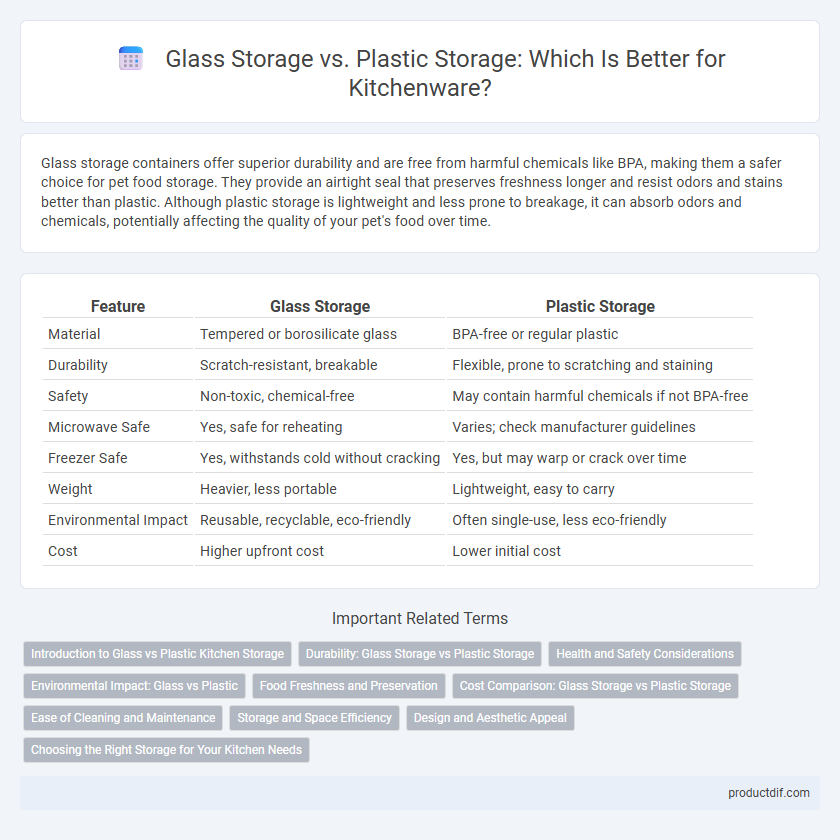Glass storage containers offer superior durability and are free from harmful chemicals like BPA, making them a safer choice for pet food storage. They provide an airtight seal that preserves freshness longer and resist odors and stains better than plastic. Although plastic storage is lightweight and less prone to breakage, it can absorb odors and chemicals, potentially affecting the quality of your pet's food over time.
Table of Comparison
| Feature | Glass Storage | Plastic Storage |
|---|---|---|
| Material | Tempered or borosilicate glass | BPA-free or regular plastic |
| Durability | Scratch-resistant, breakable | Flexible, prone to scratching and staining |
| Safety | Non-toxic, chemical-free | May contain harmful chemicals if not BPA-free |
| Microwave Safe | Yes, safe for reheating | Varies; check manufacturer guidelines |
| Freezer Safe | Yes, withstands cold without cracking | Yes, but may warp or crack over time |
| Weight | Heavier, less portable | Lightweight, easy to carry |
| Environmental Impact | Reusable, recyclable, eco-friendly | Often single-use, less eco-friendly |
| Cost | Higher upfront cost | Lower initial cost |
Introduction to Glass vs Plastic Kitchen Storage
Glass storage containers offer superior durability and are non-porous, preventing stains and odors, while plastic storage is lightweight and usually more affordable. Glass withstands higher temperatures, making it ideal for microwave and oven use, whereas plastic can warp or release chemicals when heated. Choosing between glass and plastic storage depends on factors like safety, environmental impact, and convenience in day-to-day kitchen use.
Durability: Glass Storage vs Plastic Storage
Glass storage containers generally offer superior durability due to their resistance to scratches, stains, and odors, maintaining clarity and integrity over time. Plastic storage containers are more prone to wear, including scratches and warping, especially when exposed to heat or harsh cleaning agents. Choosing glass over plastic enhances long-term usability and preserves food quality without retaining odors or discoloration.
Health and Safety Considerations
Glass storage containers offer superior health benefits by being non-toxic and free from harmful chemicals such as BPA, commonly found in some plastic containers. Glass is more resistant to staining and odors, reducing the risk of bacterial contamination and ensuring safer food preservation. In contrast, plastic storage can release toxins when exposed to heat or wear, posing potential health risks, making glass the safer choice for long-term food storage.
Environmental Impact: Glass vs Plastic
Glass storage containers are more environmentally friendly due to their recyclability and durability, which reduces waste and resource consumption over time. Plastic storage, especially single-use varieties, contributes significantly to pollution and often ends up in landfills or oceans, posing threats to wildlife and ecosystems. Choosing glass over plastic supports sustainability by minimizing toxic chemical leaching and encouraging long-term reuse.
Food Freshness and Preservation
Glass storage containers provide superior food freshness and preservation by offering an airtight seal that prevents moisture and air from entering, which slows down spoilage and odor absorption. Unlike plastic, glass is non-porous and does not retain stains or odors, ensuring that food tastes fresh for longer periods. Studies show that glass storage can extend the shelf life of perishable items by maintaining stable temperatures and preventing chemical leaching that occurs with some plastics.
Cost Comparison: Glass Storage vs Plastic Storage
Glass storage containers typically have a higher upfront cost compared to plastic storage, with prices ranging from $10 to $30 per piece depending on size and brand. Plastic storage options are more budget-friendly, often priced between $2 and $10, making them a cost-effective choice for large quantity purchases. While glass offers durability and long-term savings due to its resistance to staining and odor retention, plastic may require more frequent replacement, impacting overall cost efficiency.
Ease of Cleaning and Maintenance
Glass storage containers are easier to clean due to their non-porous surface, which resists staining and odor retention, unlike plastic containers that can absorb food smells and discolor over time. They are dishwasher-safe and less prone to retaining grease, making maintenance straightforward and hygienic. Plastic containers often require more careful cleaning to prevent scratches and buildup, impacting their longevity and cleanliness.
Storage and Space Efficiency
Glass storage containers offer superior stackability and airtight seals, maximizing kitchen storage space while preserving food freshness. Plastic storage is lightweight and often more versatile in shape, allowing flexible arrangement but may degrade over time, reducing space efficiency. Choosing glass enhances durability and space-saving organization, particularly in compact kitchens.
Design and Aesthetic Appeal
Glass storage containers offer a sleek, transparent design that enhances kitchen aesthetics by showcasing contents clearly, adding a modern and elegant touch. Plastic storage containers often come in a variety of colors and shapes, providing versatile design options but may lack the premium look and feel of glass. The choice between glass and plastic storage ultimately affects the visual harmony of kitchenware, with glass favored for sophistication and plastic for playful or practical appeal.
Choosing the Right Storage for Your Kitchen Needs
Glass storage containers offer superior durability, non-reactive surfaces, and maintain food freshness without absorbing odors or stains, making them ideal for long-term storage and reheating. Plastic storage containers provide lightweight convenience, affordability, and versatility with various sizes, but may retain odors and degrade faster, especially when exposed to heat. Selecting the right kitchen storage depends on balancing durability, safety, and convenience according to your cooking habits and storage preferences.
Glass Storage vs Plastic Storage Infographic

 productdif.com
productdif.com